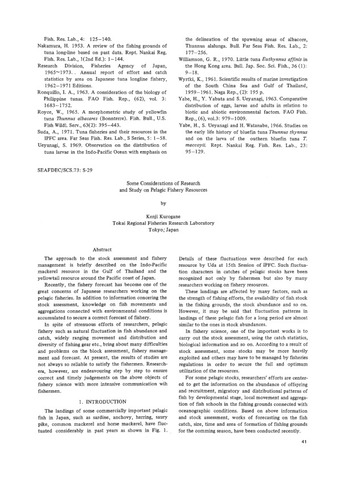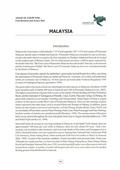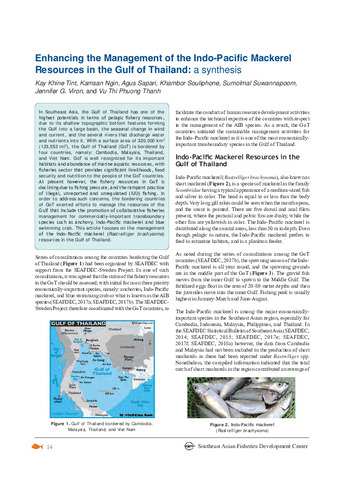Genetic mixed-stock analysis of short mackerel, Rastrelliger brachysoma, catches in the Gulf of Thailand: Evidence of transboundary migration of the commercially important fish
Share
| dc.contributor.author | Kongseng, Sirithorn | |
| dc.contributor.author | Phoonsawat, Ratanavaree | |
| dc.contributor.author | Wanchana, Worawit | |
| dc.contributor.author | Swatdipong, Akarapong | |
| dc.date.accessioned | 2021-12-06T01:17:40Z | |
| dc.date.available | 2021-12-06T01:17:40Z | |
| dc.date.issued | 2021-03 | |
| dc.identifier.citation | Kongseng, S., Phoonsawat, R., Wanchana, W., & Swatdipong, A. (2021). Genetic mixed-stock analysis of short mackerel, Rastrelliger brachysoma, catches in the Gulf of Thailand: Evidence of transboundary migration of the commercially important fish. Fisheries Research, 235, 105823. | en |
| dc.identifier.issn | 0165-7836 | |
| dc.identifier.uri | http://hdl.handle.net/20.500.12066/6733 | |
| dc.description.abstract | Short mackerel, Rastrelliger brachysoma, is one of commercially important marine species in the Gulf of Thailand. The mackerel resource has been faced with overfishing and sharply declined. Here, genetic mixed-stock analysis was performed using eleven microsatellite loci on 1675 short mackerel individuals caught, in 2014, from its four major fishing grounds of Thai waters in the Gulf of Thailand. Short mackerel populations from Thai, Cambodian, Vietnamese and Malaysian waters in the Gulf of Thailand were used as baselines. The mixed-stock analysis revealed that these populations significantly contributed to catches of the four fishing grounds in Thai water. The Samut Songkhram population, representing sedentary behavior, was the major contributor (52.71 %) to the total catch from the Inner Gulf of Thailand. The Surat Thani population dominantly contributed 46.23 % to the total catch from lower part of the Central Gulf of Thailand, where the fishing ground surrounds its spawning ground. The populations from Cambodia and Malaysia corporately contributed of 70.95 % and 87.88 % to the total catches from the Eastern Gulf of Thailand and upper part of the Central Gulf of Thailand, respectively. According to these analysis results, the populations from neighboring countries to Thailand displayed transboundary migration and significantly contributed to fishery catches in the Thai water. Therefore, profound sub-regional cooperation from Gulf of Thailand countries is required for effective fishery management of the short mackerel resource to be sustainable. | en |
| dc.description.sponsorship | Funding of this study was provided under the Biodiversity-Based Economy Development Office (Public Organization), the Department of Fisheries, SEAFDEC and the Development and Promotion for Science and Technology talents project (DPST), Thailand. | en |
| dc.language.iso | en | en |
| dc.publisher | Elsevier | en |
| dc.relation.uri | https://inter.fisheries.go.th/eng/en_pic/202103010935411_file.pdf | |
| dc.subject | fishery management | en |
| dc.subject | Mixed-stock analysis | en |
| dc.subject | Rastrelliger brachysoma | en |
| dc.subject | mackerel | en |
| dc.subject | Gulf of Thailand | en |
| dc.subject | Transboundary migration | en |
| dc.subject | Thailand | en |
| dc.title | Genetic mixed-stock analysis of short mackerel, Rastrelliger brachysoma, catches in the Gulf of Thailand: Evidence of transboundary migration of the commercially important fish | en |
| dc.type | Article | en |
| dc.citation.volume | 235 | en |
| dc.citation.spage | 105823 | en |
| dc.citation.journalTitle | Fisheries Research | en |
| dc.subject.asfa | mackerel fisheries | en |
| dc.subject.asfa | migration | en |
| dc.subject.asfa | commercial species | en |
| dc.subject.asfa | fisheries | en |
| dc.subject.asfa | DNA | en |
| dc.subject.asfa | microsatellites | en |
| dc.subject.asfa | genotyping | en |
| dc.subject.asfa | genetic diversity (as resource) | en |
| dc.identifier.doi | 10.1016/j.fishres.2020.105823 |
Files in this item
This item appears in the following Collection(s)
-
Secretariat Journal Articles [6]
These papers were contributed by Secretariat staff to various national and international journals -
Secretariat Journal Articles published externally [6]
These papers were contributed by Secretariat staff to various national and international journals



